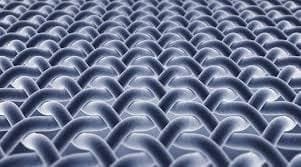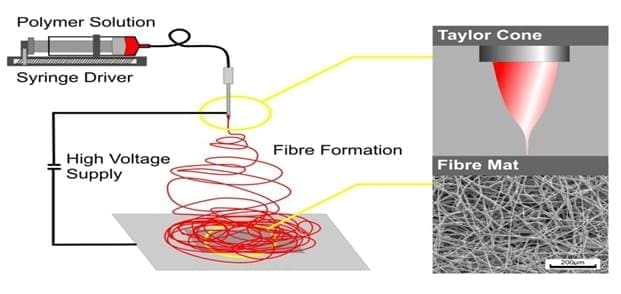Prof. Tanveer Malik, Prof. Shyam Barhanpurkar, Prof. Yogita Agrawal & Prof. Tapan Kumar Sinha
*Facuties, Department of Textile Technology
Shri Vaishnav Institute of Technology and Science, indore
Introduction:
Electrospinning can be described as a process which utilizes the electrostatic attraction between a charged polymer and a grounded or oppositely charged collection plate within an electric field i.e. in the this process a high voltage is used to create an electrically charged jet of polymer solution or melt, which dries or solidifies to leave a polymer fiber.
History:
In the late 1500s Sir William Gilbert describe the behavior of magnetic and electrostatic phenomena. During experiment he observed that when a suitably electrically charged piece of amber was brought near a droplet of water it would form a cone shape and small droplets would be ejected from the tip of the cone: this is the first recorded observation of electrospraying. The process of electrospinning was patented by J.F Cooley in February 1902 (U.S. Patent 692,631) and by W.J. Morton in July 1902 (U.S. Patent 705,691). In 1914 John Zeleny, published work on the behavior of fluid droplets at the end of metal capillaries. His effort began the attempt to mathematically model the behaviour of fluids under electrostatic forces. Further developments toward commercialization were made by Anton Formhals, and described in a sequence of patents from 1934 (U.S. Patent 1,975,504) to 1944 (U.S. Patent 2,349,950) for the fabrication of textile yarns (a process that produced fine fibers from a cellulose acetate solution). Electrospinning from a melt instead of a solution was patented by C.L Norton in 1936 (U.S. Patent 2,048,651).
Between 1964 and 1969 Sir Geoffrey Ingram Taylor produced the theoretical underpinning of electrospinning. Taylor’s work contributed to electrospinning by mathematically modelling the shape of the cone formed by the fluid droplet under the effect of an electric field; this characteristic droplet shape is now known as the Taylor cone. In 1996 Reneker & Chun had find the probability of electrospinning using different kind of polymer solution wasproved In the 1990s many researches were to popularize electrospinning process for the production of nanofibers. After this advancement done is exponentially. Reznik et al. (2004) describes extensive work on the shape of the Taylor cone and ejection of fluid jet. Yarin et al. (2001) try to describe the most important instability, the bending (whipping) instability of electrospinning process.
Principle:
In this method electrostatic principle is used in which charge between two plate is created and one plate have connected to the syringe of very small diameter in that syringe polymermelt or solution is filled up. When the polymer is discharged from the tip of the syringe it initially held by surface tension force. This induces a charge on the surface of the liquid. Mutual charge repulsion causes a force directly opposite to the surface tension. As the intensity of the electric field is increased, the hemispherical surface of the fluid at the tip of the capillary tube elongates to form a conical shape known as the Taylor cone. With increasing field, a critical value is attained. . When the electrostatic attraction overcomes the surface tension and visco-elastic components of the polymer, the polymer droplet will ejected from a cone known as Taylor cone. The ejected polymer fluid form jet. The discharged polymer solution jet undergoes a whipping process where in the solvent evaporates, leaving behind a charged polymer fiber, which lays itself randomly on a grounded collecting metal screen.. In the case of the melt the discharged jet solidifies when it travels in the air and is collected on the grounded metal screen.
While in case of conventional fiber spinning techniques (wet spinning, dry spinning, melt spinning, gel spinning), which are producing polymer fibers with diameters down to the micrometer range, electrospinning is a process capable of producing polymer fibers in the nanometer diameter range. This electrostatic processing method uses a high- voltage electric field to form solid fibers from a polymeric fluid stream (solution or melt) delivered through a millimeter-scale nozzle. Nanofibers are the ultra-fine solid fibers notable for their very small diameters (lower than 100 nm), their large surface area per unit mass and small pore size.
Electrospinning Process Parameter:
The above description of the process suggests that the following parameters affect the process:
- Electrospinning raw material parameter
- Polymer molecular weight
- Solvent
- Concentration and viscosity
- Surface tension of polymer solution
- Conductivity of polymer solution
- Temperature of polymer solution
- Electrospinning process conditions
- Voltage
- Syringe Traverse Speed
- Distance between nozzle and collector
- Inert diameter of nozzle
- Collector shape and moving speed
- Environmental parameter
- Temperature
- Humidity
- Oxygen content
- Atmosphere (vacuum, N2,…)
- Magnetic field
Advantages of Electrospinning:
- The fibers are very thin and have a high length to diameter ratio.
- They provide a very large surface area per unit mass.
- Only a small amount of material is required.
- There is very little waste.
- The process is versatile: fibers can be spun onto any shape using a wide range of polymers.
Disadvantages of Electrospinning:
- The biggest drawback to electrospinning nanofibers is its low production rates. (Syringes can deliver material only so quickly)
- We do not yet know full interactions of parameters. Most of the papers investigate the effect of only one parameter.
- Produced nanofibers are not uniform in terms of their diameter
- Formation of defected nanofibers with beads
Increasing production from each machine will require:
- Using machines with multiple syringes.
- Applying multijet, needle-less devices, although this technology lacks repeatability for nonwovens because the jet formations are essentially random.
- Developing a new approach to obtain very high spatial control of each single jet, so as to be able to “write” with the nanowire during its production at several millimeter/second, with submillimeter resolution. With this capability, a single head with hundreds of holes can be used to maintain quality.
- Increasing the flow rate of the extruder/pump system with an advanced, high-voltage system that increases charge transfer to the polymer.
Application of Electrospinning:
- Medical: In medical electrospinning is use in following :-
· Artificial organ components;
· Tissue engineering;
· Implant materials;
-
In vivo wound healing of diabetic ulcers using electrospun nanofibers immobilized with human epidermal growth factor (EGF)
· Medical textile materials;
· Drug delivery system;
· Researchers at the University of Washington, funded in part by using a grant from the Bill and Melinda Gates Foundation, are developing futuristic nanofabric condoms that can be inserted into the penis. There they will dissolve and distribute preventive drugs, meaning they can act as a contraceptive while also preventing sexually transmitted diseases.
- Textile manufacturing: Uses are as follows
Electrospinning has the potential to produce seamless non-woven garments by integrating advanced manufacturing with fiber electrospinning.
Multi functionality(flame proof, water proof, etc. ) fabric are to be produced by blending with other poltmer.
- Filtration:
The use of nanofiber webs as a filtering medium is widely use. Air filter consisting of layered nanofibers nonwoven material developed by Donaldson. The enhanced filtration efficiency at the same pressure drop is possible with fibers having diameters less than 0.5 micrometer. Since the essential properties of protective clothing are high moisture vapor transport, increased fabric breath-ability, and enhanced toxic chemical resistance, electrospun nanofiber membranes are good candidates for these applications.
- Catalysts:
Electrospun fibers may have potential as a surface for enzymes to be immobilized on. These enzymes could be used to break down toxic chemicals in the environment, among other things. Electrospun fibers with Pd particles have 4.5 times higher catalytic activity than the current Pd/Al2O3 catalyst.
Conclusions and future perspectives:
Electrospinning is a very simple and versatile method of creating polymer-based high functional and high performance nano fibers that can revolutionise the world of structural materials. The process is versatile in that there is a wide range of polymer and biopolymer solutions or melts that can be spun. Essential studies, nevertheless, are still required and many challenges remain to be faced. In particular, integration of nano fibers into useful devices requires nano fibers of well-controlled orientation, size, and other target characteristics as well as reproducibility locating them in specific positions and orientations. The ability to do so, however, remains a major challenge in the field. The design and construction of process equipment for controllable and reproducible electrospinning could determine the character of instabilities revealed, satisfy potential implementation and act as stimulus to provide new products. Productivity improvement of the electrospinning process is also an essential feature and required more studies.
Refrences:
- Reneker DH, Chun I. Nanometre diameter fibresof polymer produced by electrospinning. Nanotechnology 1996;7:216 – 23.
- Larrondo L, Manley RSJ. Electrostatic fiber spinning from polymer melts. I. Experimental observations on fiber formation and properties. J Polym Sci Polym Phys Ed 1981;19:909 –20.
- Bognitzki M, Frese T, Steinhart M, Greiner A, Wendorff JH. Preparation of fibers with nanoscaled morphologies: electrospinning of polymer blends. Polym Eng Sci 2001;41:982 – 9.
- Bognitzki M, Wendorff JH, Greiner A. Submicrometer shaped polylactide fibers by electrospinning. Polym Prep (ACS, PMSE) 2000;82:115 –6.
- Buer A, Ugbolue SC, Warner SB. Electrospinning and properties of some nanofibers. Textile Res J 2001;71:323 –8.
- Kim J-S, Reneker DH. Polybenzimidazole nanofiber produced by electrospinning. Polym Eng Sci 1999;39:849 –54.
- Rangpukan R, Reneker DH. Development of electrospinning from molten polymersin vacuum. J Textile Apparel, Technol Manage 2001, vol. 1. Special issue: The Fiber Society Spring 2001 Conference, Raleigh NC.


